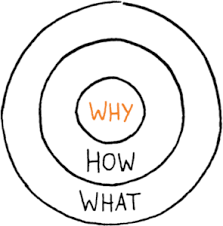Even though change is hard, there are strategies that will help navigating change a little easier. As I move forward in this program, I am appreciative of the tools I’ve gained to use with my organization.
Start with WHY
Implementing change in an existing organization will come with challenges. As I begin to implement ePortfolios into my organization of Fine Arts Dance classes, I have to remember my ‘why’ for wanting to create this change. Sharing what drives your motivation will help your team get on board with what you’re suggesting. After all, Simon Sinek reminds us “people don’t buy what you do; they buy why you do it” (TEDx Talks, 2013). This goes right along with capturing hearts and minds when presenting a new opportunity, as this creates a sense of urgency for change.
My ‘why’ for creating ePortfolios in Dance classrooms relates to instilling a love for learning while preparing students for an ever-changing world. As I present this motivation to my team members, they will be able to see the need for this implementation and how beneficial it will be to the students and teachers.
Influencer Strategy
Change is not going to happen automatically once new ideas are presented. As a leader, you will need to incorporate different strategies to help influence others to commit to the new ideas. You first need to make sure to set a measurable goal and find vital behaviors that align with success of this goal. Then, you need to engage all six sources of influence to help maximize results and create lasting change. These sources of influence may be met with resistance, but with perseverance and consistency, you will be able to see movement in the direction of your organization’s goal.
For my ePortfolio initiative, my vital behaviors include all Dance teachers creating ePortfolios and sharing ideas, strategies, and challenges as they incorporate it into their own classroom curriculum. Regular check-ins and feedback will hold each person accountable for doing their part in making this goal successful.
Installing 4 Disciplines of Execution (4DX)
Most changes require a change in a person’s behavior. Although this is not an easy task, it is essential in reaching your goal. The 4 Disciplines of Execution is a fool-proof plan to keep everyone on task and held accountable for doing their part. Focusing on the wildly important goals (WIG), acting on the lead measures, keeping a compelling scoreboard, and creating a cadence of accountability creates an environment of success in any organization.
My WIG for my ePortfolio innovation plan: We will implement ePortfolios in the dance curriculum from 0 times a week to 2 times a week by June 2022. The lead measures we will focus on to move towards our goal is teachers and students creating ePortfolios, as well as teachers assigning 2 ePortfolio activities per week. All of these measures are directly related to our wildly important goal.
Self-Differentiation & Crucial Conversations
Creating change requires effective leadership. Effective leaders are able to self-differentiate and have crucial conversations. Leaders need to be able to separate themselves from the emotions and anxiety that may arise in their organization when change is presented. They also need to be able to have tough conversations when the stakes are high and opinions vary.
I foresee crucial conversations arising and areas where self-differentiation is needed as I implement my Innovation Plan with my organization. I know that when changes are presented, not all team members will be on board. There will be differing opinions and anxieties may run high. Being able to remove myself from the emotions that may be attached with these feelings, I can have crucial conversations that are productive, healthy, and move towards action.
References
McChesney, C., Covey, S., Huling, J. (2012). The 4 disciplines of execution: Achieving your wildly important goals. Simon & Schuster.
Patterson, K., & Grenny, J. (2013). Influencer: The new science of leading change, Second Edition. McGraw-Hill Education.
Patterson, K., Grenny, J., McMillan, R., & Switzler, A. (2002). Crucial conversations: tools for talking when stakes are high. McGraw-Hill Education.
TEDx Talks. (2009, September 28). Start with why — how great leaders inspire action | Simon Sinek | TEDxPugetSound. [Video] YouTube. https://youtu.be/u4ZoJKF_VuA




